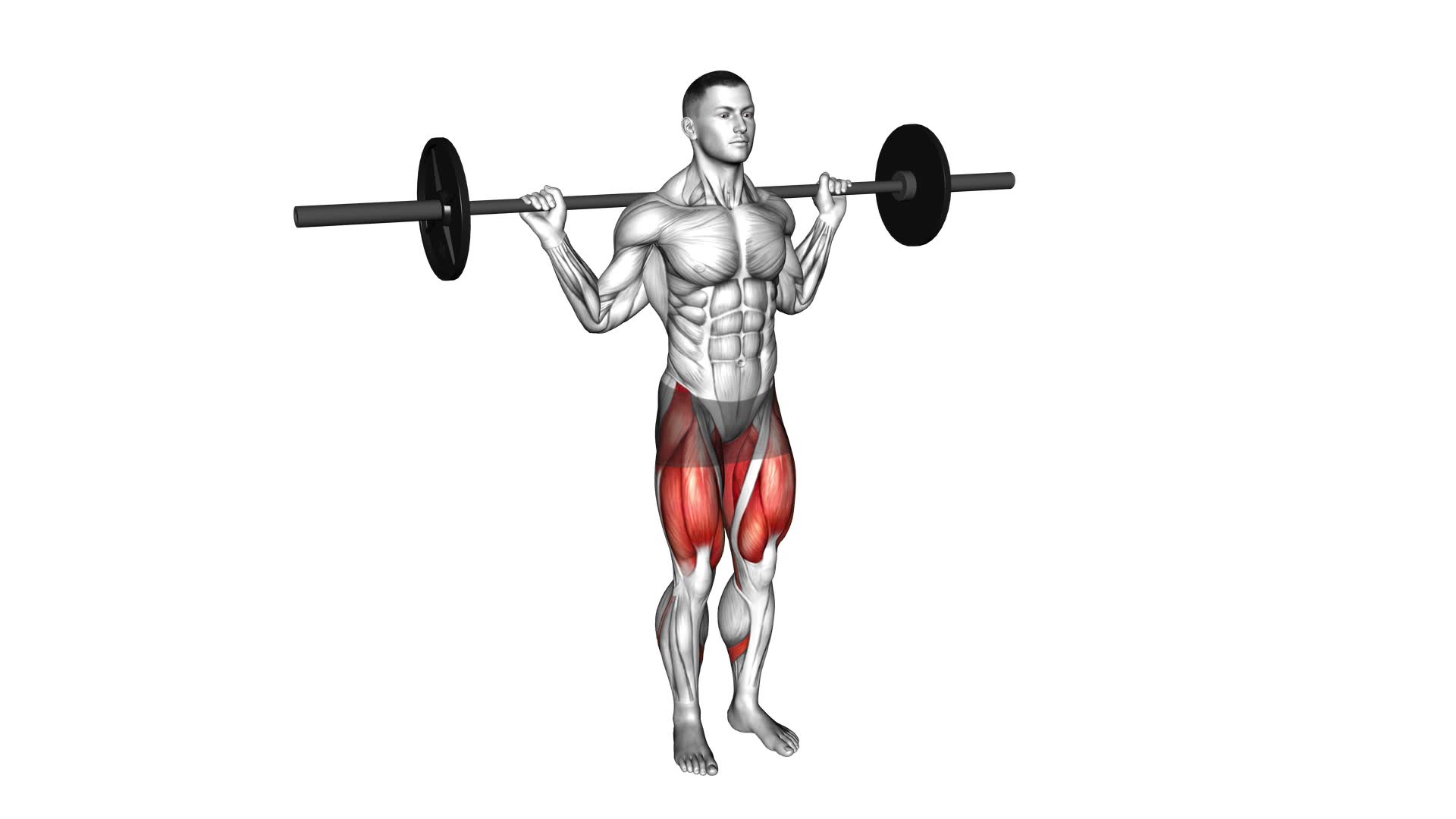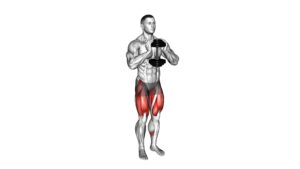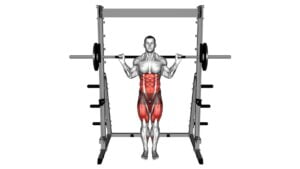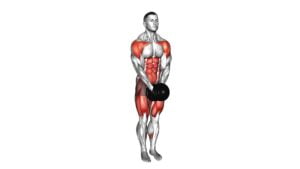Barbell Curtsy Lunge – Video Exercise Guide & Tips

Are you looking to level up your leg workout? Look no further than the barbell curtsey lunge. This exercise targets your glutes, quads, and hamstrings, helping you build strength and definition.
Watch This Exercise Video
In this video exercise guide, we'll show you how to properly set up and perform the barbell curtsey lunge, along with variations and progressions to challenge yourself.
Maximize your workout with these tips and get ready to feel the burn!
Key Takeaways
- Targets glutes, quads, and hamstrings
- Improves balance, stability, and coordination
- Can be modified with dumbbells for easier balance
- Gradually increase weight as comfort and confidence with the exercise improve
Benefits of Barbell Curtsey Lunges
You can experience numerous benefits by incorporating barbell curtsey lunges into your workout routine. These lunges specifically target several key muscles in your lower body, including your glutes, hamstrings, quadriceps, and adductors. By engaging these muscles, barbell curtsey lunges can help you develop stronger and more defined legs and buttocks.
Compared to traditional lunges, barbell curtsey lunges offer some unique advantages. While both exercises work similar muscle groups, the barbell curtsey lunge places more emphasis on the adductors and glutes. This variation also requires greater balance and stability, as you're crossing one leg behind the other, challenging your core muscles and improving overall coordination.
Transitioning into the subsequent section about how to set up for barbell curtsey lunges, it's important to note that these benefits can be maximized by proper form and technique. To perform this exercise, you'll need a barbell placed across your upper back, with your feet shoulder-width apart. From there, step one foot diagonally behind the other, lowering your body into a lunge position. Remember to keep your back straight and chest lifted throughout the movement.
Incorporating barbell curtsey lunges into your workout routine can provide numerous benefits for your lower body strength and overall fitness.
How to Set Up for Barbell Curtsey Lunges
To set up for barbell curtsey lunges, begin by placing a barbell across your upper back and standing with your feet shoulder-width apart. This exercise is a variation of the traditional curtsey lunge, adding the challenge of using a barbell for additional resistance.
When setting up for barbell curtsey lunges, it's important to maintain proper form to maximize the effectiveness of the exercise and minimize the risk of injury. Keep your core engaged and your chest lifted throughout the movement. As you perform the lunge, make sure to keep your front knee aligned with your ankle and avoid letting it collapse inward.
If you're a beginner or have difficulty balancing with a barbell, you can modify the exercise by using dumbbells instead. Hold a dumbbell in each hand and perform the curtsey lunge with the same form and technique as with the barbell. This modification allows for easier balance and control.
Common mistakes in barbell curtsey lunges include not fully extending the back leg and not maintaining proper alignment of the front knee. Make sure to fully extend your back leg before returning to the starting position to fully engage the glutes and hamstrings. Additionally, keep your front knee aligned with your ankle to avoid unnecessary strain on the knee joint.
Proper Form and Technique for Barbell Curtsey Lunges
Maintain proper form and technique when performing barbell curtsey lunges to effectively target your glutes, thighs, and hips while minimizing the risk of injury. To ensure proper form, start by standing with your feet hip-width apart and the barbell resting on your upper back. As you step your left leg diagonally behind your right leg, lower your body into a lunge position, making sure your right knee stays in line with your right ankle. Keep your chest up, core engaged, and shoulders back throughout the movement. Push through your right heel to return to the starting position, and then repeat on the other side.
To maximize the benefits of barbell curtsey lunges, it's important to avoid common mistakes. One common mistake is allowing the front knee to track too far forward, which can put excessive strain on the knee joint. Another mistake is leaning forward or rounding the back, which can compromise your form and lead to back pain. Remember to keep your torso upright and your spine neutral throughout the exercise.
Barbell curtsey lunges primarily target the glutes, thighs, and hips. The gluteus maximus, quadriceps, hamstrings, adductors, and abductors are all engaged during this exercise. By incorporating barbell curtsey lunges into your workout routine, you can strengthen and tone these muscles for improved lower body strength and stability.
Now that you understand the proper form and technique for barbell curtsey lunges, let's explore some variations and progressions that you can incorporate into your workouts to challenge yourself even more.
Variations and Progressions for Barbell Curtsey Lunges
To enhance the effectiveness of your barbell curtsey lunges, incorporate variations and progressions that challenge and engage your muscles even further.
Advanced modifications of the barbell curtsey lunge include adding a hop at the end of each rep to increase explosiveness and plyometric power. This variation not only targets your lower body muscles but also improves your overall athleticism.
Another advanced modification is the barbell curtsey lunge with a twist. As you come up from the lunge, twist your torso towards the side of the front leg. This engages your obliques and adds an element of core stability to the exercise.
When performing these advanced variations, it's important to maintain proper form to prevent injury. One common mistake is allowing your knee to cave inwards during the lunge. Keep your knee aligned with your toes to protect your knee joint.
Another mistake is rushing through the movement. Slow down and focus on the mind-muscle connection to make every rep count.
Lastly, avoid using excessive weight that compromises your form. Start with lighter weights and gradually increase the load as you become more comfortable and confident with the exercise.
Tips for Maximizing Your Barbell Curtsey Lunge Workout
Looking to maximize your barbell curtsey lunge workout? Here are some tips to help you get the most out of this exercise.
One common mistake is using too much weight. It's important to start with a weight that you can control and maintain proper form throughout the exercise. A recommended weight to start with is around 50-60% of your one-rep max for the barbell squat.
Another common mistake isn't maintaining proper form. Make sure to keep your chest up, shoulders back, and core engaged throughout the movement. As you step back into the curtsey lunge, focus on keeping your front knee in line with your toes and your back knee hovering just above the ground. This will ensure that you're targeting the right muscles and preventing any unnecessary strain on your joints.
To further maximize your workout, try incorporating different variations and progressions of the barbell curtsey lunge. This can include adding weights to the exercise, performing it on an unstable surface, or adding a plyometric element to increase the intensity.
Frequently Asked Questions
How Many Sets and Repetitions Should I Do for Barbell Curtsey Lunges?
To determine the number of sets and reps for barbell curtsey lunges, consider your fitness level and goals. Generally, aim for 3-4 sets of 8-12 repetitions. This range promotes muscle growth and strength.
Incorporating barbell curtsey lunges into your leg workout routine offers several benefits. It targets your glutes, quads, and hamstrings, enhancing lower body strength and stability.
Additionally, the exercise improves balance and coordination, making it a valuable addition to your fitness routine.
Can I Use Dumbbells Instead of a Barbell for Curtsey Lunges?
Yes, you can definitely use dumbbells instead of a barbell for curtsey lunges.
The dumbbell variations of this exercise offer several benefits. They help improve stability and balance, as you have to engage your core to control the weight.
Additionally, using dumbbells allows for unilateral training, targeting each leg individually. This can help identify and correct any strength imbalances between your legs.
Are Barbell Curtsey Lunges Suitable for Beginners?
Barbell curtsey lunges can be a challenging exercise for beginners. However, there are modifications you can make to suit your fitness level. When starting out, you can use lighter weights or even perform the exercise without any weights at all. As you progress, gradually increase the weight to build strength and stability.
The benefits of barbell curtsey lunges include targeting the glutes, quads, and hamstrings, improving balance, and enhancing overall lower body strength.
Should I Perform Barbell Curtsey Lunges Before or After Other Leg Exercises?
To maximize the effectiveness of your leg workout routine, consider incorporating barbell curtsey lunges. These lunges have several benefits, such as targeting different muscles and improving balance.
When deciding whether to perform them before or after other leg exercises, it ultimately depends on your training goals. Doing them before can activate the muscles and prepare them for the rest of your workout.
However, doing them after can help burn more calories and increase overall leg strength. Experiment and see what works best for you.
Are There Any Common Mistakes to Avoid When Performing Barbell Curtsey Lunges?
When performing barbell curtsey lunges, it's important to be aware of common mistakes to avoid. Proper form is key to getting the most out of this exercise.
One common mistake isn't maintaining a straight back throughout the movement, which can put unnecessary strain on your spine.
Another mistake is allowing your knee to extend past your toes, which can lead to knee pain and injury.
Conclusion
In conclusion, barbell curtsey lunges are a highly effective exercise for targeting the glutes, quads, and hamstrings. By adding resistance with a barbell, you can further challenge your muscles and increase strength and stability.
Remember to maintain proper form and technique throughout the movement to maximize results and prevent injury.
With variations and progressions, you can continue to challenge yourself and see continued progress.
Incorporate these tips into your workout routine to make the most out of your barbell curtsey lunge workout.

Author
Years ago, the spark of my life’s passion ignited in my mind the moment I stepped into the local gym for the first time. The inaugural bead of perspiration, the initial endeavor, the very first surge of endorphins, and a sense of pride that washed over me post-workout marked the beginning of my deep-seated interest in strength sports, fitness, and sports nutrition. This very curiosity blossomed rapidly into a profound fascination, propelling me to earn a Master’s degree in Physical Education from the Academy of Physical Education in Krakow, followed by a Sports Manager diploma from the Jagiellonian University. My journey of growth led me to gain more specialized qualifications, such as being a certified personal trainer with a focus on sports dietetics, a lifeguard, and an instructor for wellness and corrective gymnastics. Theoretical knowledge paired seamlessly with practical experience, reinforcing my belief that the transformation of individuals under my guidance was also a reflection of my personal growth. This belief holds true even today. Each day, I strive to push the boundaries and explore new realms. These realms gently elevate me to greater heights. The unique combination of passion for my field and the continuous quest for growth fuels my drive to break new ground.







